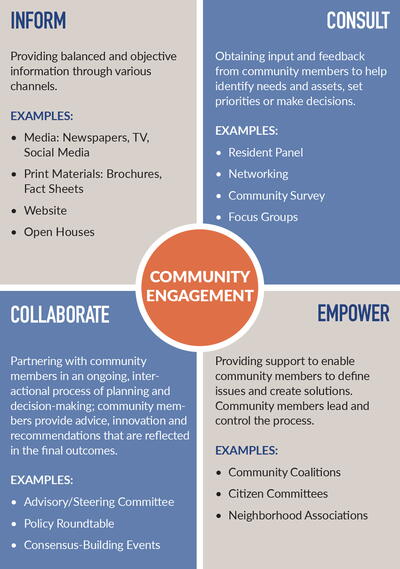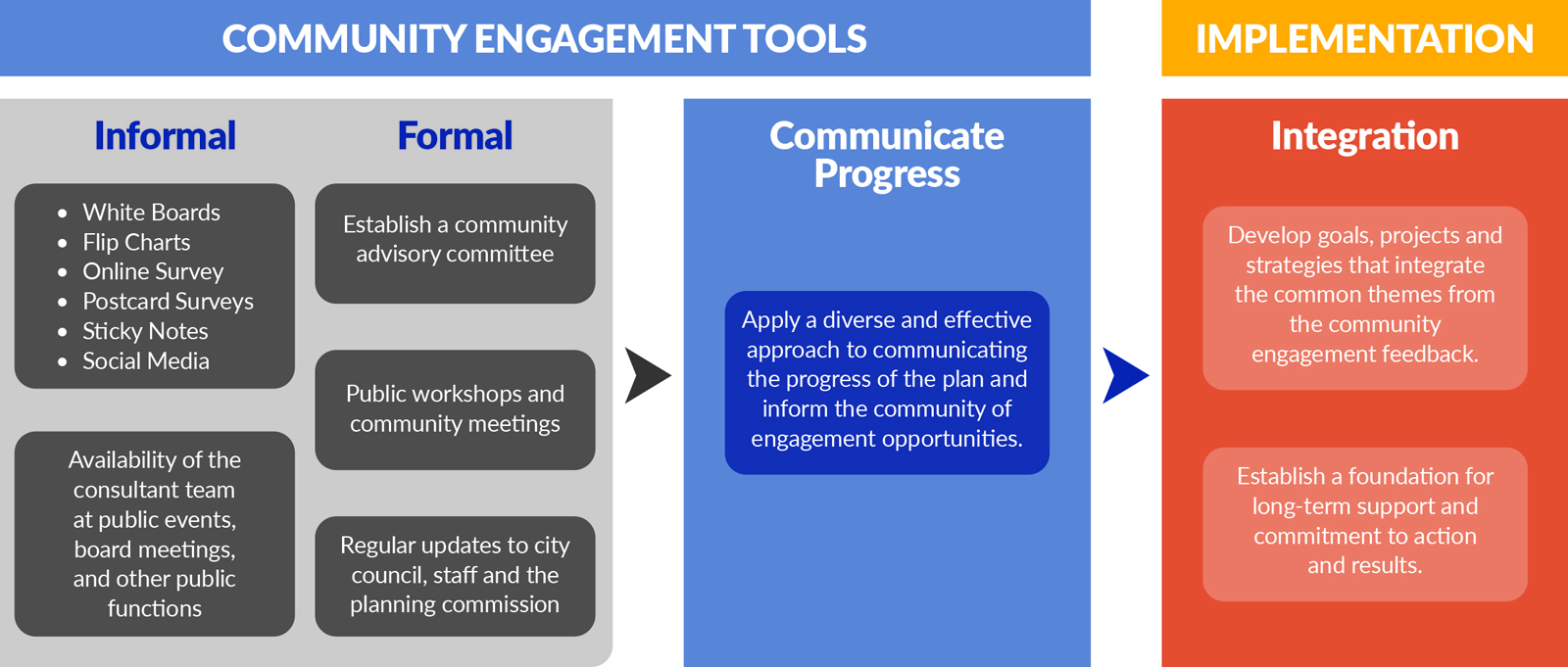
We all know that it can be especially challenging right now to have inclusive community engagement and outreach. Not only are there the traditional concerns of apathy, time constraints, and conflicting priorities, but the pandemic has created additional barriers for our communities:
• Access (equipment, transportation, internet service).
• Mandated safety protocols for attendance and spacing.
• Comfort with virtual settings.
As the world continues to grow more diverse, it is more important than ever to take the time to be deliberately inclusive in our community engagement strategies. Inclusive means “not excluding any of the parties or groups involved,” but even more so, to make participants feel welcome, valued, and included in our work. Numerous studies have shown that inclusivity results in better outcomes: more creative ideas, strengthened communication, robust support for results, and deeper relationships.
So how do we continue to foster and facilitate inclusive community engagement even when faced with ongoing and unique challenges? With a deliberative and intentional focus on thinking inclusively.
There are four general levels to community engagement: inform, consult, collaborate, and empower. Consulting, collaborating, and empowering are all examples of being more inclusive. Many local governments already do an amazing job of informing their communities with inclusion in mind—examples would include printing materials or creating documents in multiple languages. Consulting with your community is also an approach that is often used in engagement—surveys and community meetings are good examples. However, if inclusivity is truly a goal, there needs to be a focus on collaboration and empowerment with the community, which often means changing an approach or even sharing decision making.

Facilitation as a Tool for Inclusivity
As leaders and managers, we all have tools in our toolbox to use during community engagement. Using facilitative techniques is one of the most meaningful tools local government can use to foster inclusion and create a process for community engagement that is welcoming and results in stronger support.
Facilitation is a tool that inherently creates inclusivity—as a facilitator you are a guide, a motivator, a bridge builder, a cheerleader, and an active listener. Facilitation is a very different approach from the way most community engagement is designed. Instead of presenting, a facilitator will ask questions. Instead of telling the community what might happen, a facilitator will create opportunities for the community to tell us. Instead of presenting a conclusion, a facilitator guides the participants to reach a consensus-based decision.
Recently I had the opportunity to conduct an inclusive community engagement process. Because the core approach was to include as many people and businesses as possible in the project, we started by designing some questions before designing the process—in essence, allowing the participants to tell us what participation would look like (also known as “creating the table”). We asked the question, “What would the practice of inclusion in our strategic plan process look like to you?”
The feedback had some common themes:
• Meeting people where they are (literally and figuratively).
• Not just creating a seat at the table, but allowing others to help design the table.
• Listening to learn, improve, and understand.
• Partnering with existing established groups in the community to help with the process (faith based, language based, service based, specific agencies focused on serving populations).
• Designing multiple opportunities to engage (social media, online surveys, mailed/postcard surveys, small group meetings, videos, pop-up white boards, sticky notes, online platforms).
• With intention and integrity, invite people to lead so that staff and boards are truly reflective of the community.
Steps in Creating an Inclusive Process
When designing a community engagement process that has a focus on including people, it is helpful to work in steps, always thinking of the question, “What would inclusivity look like?”
#1 Determine the outcome of our engagement: Are you trying to inform your community about an important event? Encourage feedback or participation? Develop a deeper understanding on a specific topic? Create support for a specific action?
#2 Know your community demographics: Who lives in your community? Where do they live? What languages do they speak? How do they currently receive important information? Do they have a learning preference (reading a printed newsletter or social media)? What are the barriers to their engagement with you? Are there areas or groups that you normally do not engage with that should be a part of this process?
#3 Evaluate the resources that your community has available. This might mean physical meeting spaces (libraries, businesses, community centers, service organizations, faith-based locations); communication platforms (social media channels, virtual meetings, website engagement, newsletters, billing inserts, message boards); opportunities (events, school, or sports activities); and potential partners.
#4 Identify the barriers to participation: What access does your community have to transportation, the internet, public meetings, interpreters, childcare (so they can attend uninterrupted), and so on. When you find barriers, develop potential solutions that can encourage participation.
#5 Prepare your tools and techniques that you plan to use: On-site visits, printed materials, social media posts, webpages, radio, television, newspaper, surveys, personal interviews, text announcements, billing inserts, newsletters, presenting at meetings or events, focus groups, task forces, advisory groups, sticky notes, or white boards.
#6 Create a written process for your engagement and outreach at various levels. Do not panic here—your process does not have to be a policy; think of it as a guidebook or short manual on what to do and when. Do not forget to ask people in the community if you have missed important points, opportunities, or barriers.
#7 Draft your specific outreach and engagement plan for your audience using all of these steps. Make some graphic mockups of your messaging and photos/graphics. Do not forget learning preferences: make sure you address visual, audio, and even kinesthetic learning styles.
Now is the time to come full circle back to the initial question that was so intriguing: what would inclusivity look like? Take that specific outreach and engagement plan and ask the very people you are trying to reach if in fact it would encourage their participation and make them feel welcome and included in your process. Allow them to suggest improvements to your plan, even if those improvements might make you stretch or feel uncomfortable.
Now that you have a plan to engage with your community, how can you facilitate that engagement to be inclusive? Remember that facilitation is 80 percent listening and 20 percent presenting. And one of the critical factors in being a good listener is to facilitate great questions.

The Approach to Inclusive Facilitation
Facilitation that is focused on being inclusive is created intentionally. For every hour of a meeting, crafting the facilitation process might take two or more hours. Setting some ground rules is always helpful, such as:
• Every idea is a good idea.
• Respect the speaker, even if you disagree with the idea.
• Everyone will have an opportunity to speak if they want.
• All are equal in the room.
• “None of us is as smart as all of us.”
Once ground rules have been determined, engagement activities and great questions can be designed. Both questions and activities should focus on inclusion, which means the technique should:
• Recognize neutrality: gender, race, age, sexual orientation, ethnicity, income, and different abilities.
• Realize that everyone has a perspective that they bring to the table that is valuable.
• Treat every answer with respect and dignity.
• Create the space and time to have a full discussion.
• Allow for full expression of cultural differences.
• Integrate with different thinking preferences (writing, speaking, drawing, watching).
• Meet participants where they are (questions for a team of engineers may be phrased differently than questions for a group of grade school children).
• Build stronger relationships and understanding.
How to Ask Inclusive Questions
Great questions are based on the foundation of inclusive facilitation and follow the ground rules. Crafting great questions that will promote involvement and engagement is an art and a science. The best inclusive questions have these elements:
• They are open ended.
• They are designed to spark imagination.
• They are easy to understand.
Here are some examples you can adapt to your own meetings:
• Imagine (insert the outcome here: vision, successful ballot measure, etc.)
• What will it look like?
• What will it feel like?
• What will you see?
• What do you want to preserve, no matter what else happens?
• What else?
• Anything else?
• If you could wave a magic wand…
• If money were no object…
• How can we make the biggest impact on _____?
• What are the obstacles you see that might get in our way?
• What would be the most helpful to you?
• What can we improve?
• What else should we know that can help you?
Summary
As we all shift and adapt to new circumstances, we have new opportunities to engage with our communities. Being inclusive in that engagement just makes good sense. And with facilitation as a tool and a technique, your results can change from apathetic to excited, limited to expansive, and from frustrating to encouraging. With some thoughtful planning, careful consideration, community research, and a strong commitment to listening, every community engagement opportunity can be inclusive and welcoming. Making a few small changes in the process and the questions asked during community engagement will drive better understanding, deeper support, and a caring community.

SHERYL TRENT has over 28 years of local government experience and is the owner of SBrand Solutions (sheryl@sbrandsolutions.com).
New, Reduced Membership Dues
A new, reduced dues rate is available for CAOs/ACAOs, along with additional discounts for those in smaller communities, has been implemented. Learn more and be sure to join or renew today!
